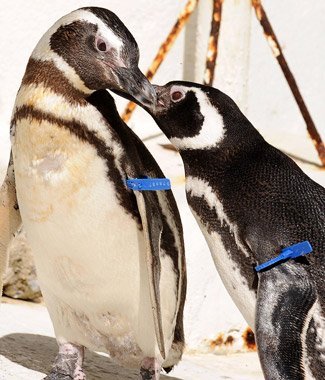Studying penguins may harm them

SOME SCIENTISTS STUDYING penguins may be inadvertently harming them with the metal bands they use to keep track of the black and white seabirds, a new French study says.
The survival rate of King penguins with metal bands on their flippers was 44 per cent lower than those without bands; banded birds also produced far fewer chicks, according to new research published on Wednesday in the journal Nature.
The theory is that the metal bands – either aluminum or stainless steel – increase drag on the penguins when they swim, making them work harder, the study’s authors say.
Author Yvon Le Maho of the University of Strasbourg in France, says the banded penguins looked haggard, appearing older than their actual age.
Consequently, studies that use banded penguins – including ones about the effects of global warming on the seabirds – may be inaccurate, mixing up other changes in penguin life with the effects from banding, says Le Maho and colleague Claire Saraux.
Yvon says this is the first study showing a long-term harm from banding penguins. “There is an ethical question: should we continue” with banding penguins? he asks. The very act of studying the birds is harming them, he says.
Penguins’ lives cut short
The researchers followed 50 already banded adult penguins and 50 without bands on a French island in the Indian Ocean between Africa and Antarctica for 10 years, tracking them with under-the-skin transponders. About a third of the non-banded seabirds survived for 10 years, compared to only 20 per cent of the band-wearing birds.
In general, penguins live about 20 years. King penguins – among the largest penguins at 1 m tall – can live even longer. The no-band penguins were found to have 80 chicks, while the banded seabirds produced 47 chicks, a 41 per cent drop.
Penguin researchers have long debated the use of bands, which weigh just under 30 grams and are a bit more than an 2.5 cm wide, Claire says.
One prominent American penguin researcher, P. Dee Boersma of the University of Washington, has been banding another kind of penguin for 28 years and will continue.
“Their study shows that the bands they used on King penguins were a problem,” she wrote in an email. “You don’t want to say all flipper bands are terrible because the evidence is not there.”
Dee says the difference in species matters. She pointed to a 14-year study she did that showed that male Magellenic penguins with two bands survived the same as unbanded penguins, but that study did show that double-banded females had a lower survival rate.
Band bias for penguins
Yvon says he sees no reason why bands would harm some penguin species but not others.
Another expert, who was not part of the French study, says he found the case against banding convincing. Norman Ratcliffe of the British Antarctic Survey, which no longer uses bands, says it “augments a growing body of evidence” that bands harm the penguins and may bias the studies.
There is an alternative to the metal bands, Ratcliffe and the French researchers say. That’s using transponder tags that are injected under the penguin’s skin and send radio signals to buried antennas, much like pets with radio chips embedded in them.
The seabirds spend more time in the water than on land, and the transponder doesn’t affect the penguin’s swimming, Claire says. But Yvon says this technique is a bit more expensive and has some other drawbacks.
The scientists singled out potential problems with research on global warming’s effect on penguins. Banding may have skewed the data, but climate change is still harming and will harm penguins, they said.
A study Claire did a couple years ago – without bands – showed harm to penguins from global warming, she says.
RELATED STORIES

